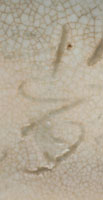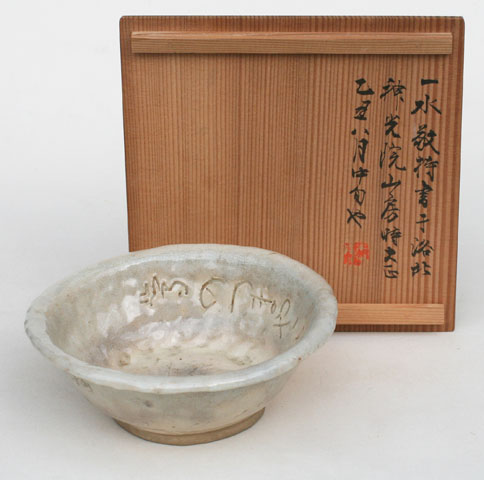Kyôyaki
Kashibachi, bowl - The warbler’s loverSigned: Rengetsu
Seals:
Technique: Handshaped cream glazed kyôyaki with incized poem Ø 16,7 x 6,7 (6)
Box: Authorized in 1925 at the Jinko-in by Issui (1863-1945)
Condition: fine
鶯のつまやこもると ゆかしきは〔知りたいのは〕 梅咲きかこむ 庵の八重垣
Uguisu no / tsuma ya komoru to / yukashiki wa / ume saki kakomu / io no yaegaki.
Is the warbler’s / lover hidden there? / I’d like to peek / into the plum blossoms / ringing this rustic hut.
(Rengetsu # 16)
Rengetsu was born In Kyoto and within a few days after her birth adopted by the Ôtagaki family. In 1798 she moved to Kameoka castle to serve the Matsudaira family. Here she met with the woman pursuits as poetry and calligraphy, but received in training in martial arts as well. In 1807 she returned to her family in Kyoto where she married her adopted brother a young samurai called Mochihisa. In the 8 years of her marriage she gave birth to e children who all died shortly after their birth. In 1815 she divorced her husband who would shortly die. She remarried but already in 1823 her second husband died. She cut her hair and became a nun and took the name Rengetsu, Lotus moon.
With her daughter from her second marriage and stepfather she moved into a small building on the grounds of the Chion-in. Two years later her daughter died. She started composing waka poetry, but without means for support she moved to Okazaki in the area of Kyoto to produce pottery, studied waka intensively and studied Shijô painting with Matsumura Keibun (1779-1843) fell in love with him and lived together. In Okazaki a place with many artists she intensively trained to study waka. Although being a nun men approached her with advances, but not being interested, she pulled out her teeth to look less attractive and to strengthen her inner self Her pottery became such a big success that she escaped her customers many times and moved more than 30 times in one year even 13 times.
She became friends with Tomioka Tessai (1836-1924) and even tried to adopt him as a son. For the last 25 years of her life he helped and accompanied her. On the invitation of the Abbot Wada Gesshin (Gozan) (1800-1870) she spent her last 10 years of her life in a tea hut the Jinko-in temple and deeply immersed herself in the study of Buddhism and but also continued her artistic occupations.
Reference:
Kyoto 2014
Canberra 2007
Rengetsu 1971
Price: ON REQUEST

